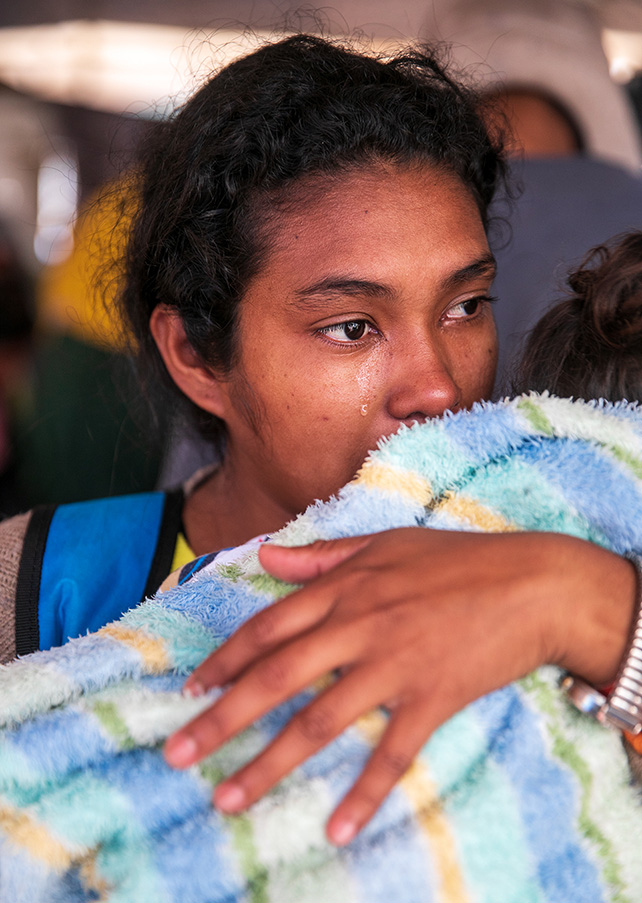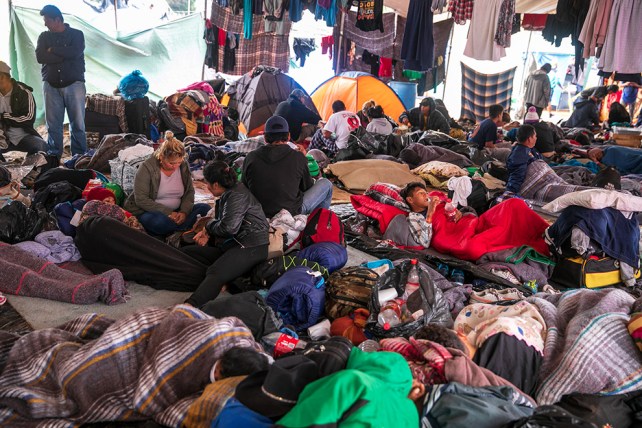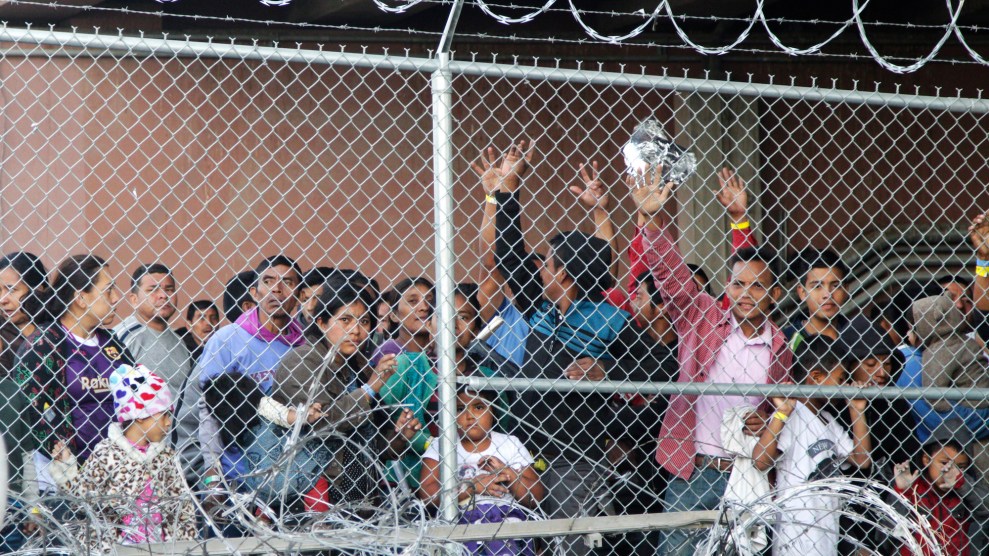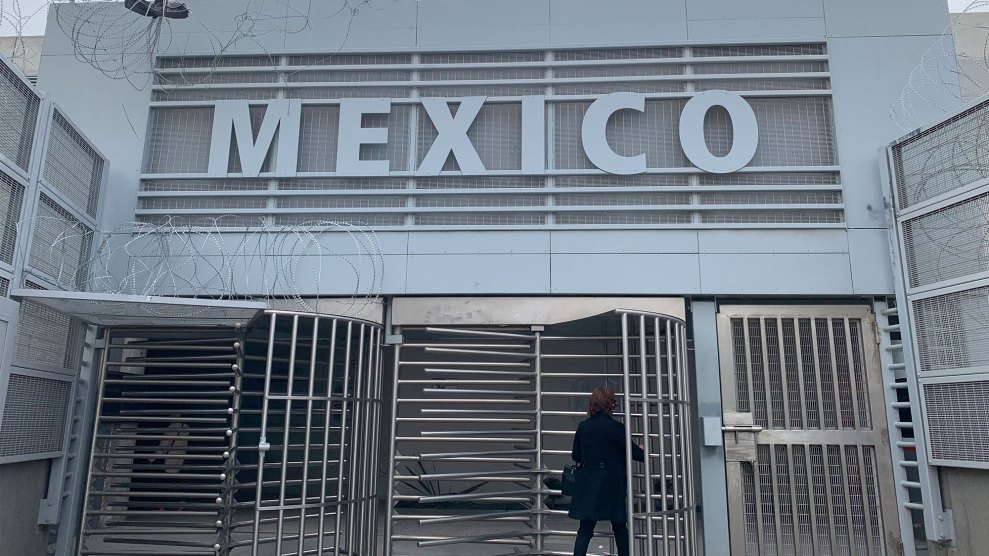
A 10-month-old looks out from his family's tent in a shelter for migrants in Tijuana, Mexico.AP Photo/Gregory Bull
Juan was standing with his wife and three young kids, clenching a tiny piece of paper with a four-digit number written on it. “We didn’t make it today,” he said. He then rolled his suitcase away from the line of people that had formed against a wall in the shadow of an overpass in Tijuana, alongside giant letters spelling out “Mexico” right on the border. “We are seven numbers short.” That morning, about 50 lucky people ahead of him had their numbers called.
Juan and his family, who are from El Salvador, had spent seven weeks in the city, sleeping in shelters, waiting like countless others for their lifeline to be called. If everything worked as promised and the next 50 numbers were called in order, tomorrow would be their day to present themselves at the San Ysidro port of entry and ask for asylum in the United States. “Hopefully,” Juan said.
Listen to immigration reporter Fernanda Echavarri talk about the border crisis you haven’t heard about, with host Jamilah King on the Mother Jones Podcast.
As he told me this, his six-year-old son walked up to introduce himself. He was wearing a beanie with fuzzy koala ears and was carrying a blanket, he said, “because it gets very cold here.” Juan, who is in his mid-30s, delivered bread back home. He told me they had left El Salvador because gang violence had gotten so bad that he wouldn’t let his kids play outside, and he feared for his life. He knew the process of seeking asylum wouldn’t be quick or easy, but he didn’t expect to reach the US-Mexico border and find himself on a waitlist with more than 2,000 names ahead of his.
President Donald Trump declared a national emergency in February so he could fund his border wall, warning of a “border security and humanitarian crisis that threatens core national security interests.” But when I visited Tijuana in the following weeks, it was clear that the real emergency was the bottleneck at the border that Trump himself had created. Thousands of Central American migrants are now stuck in one of Mexico’s most dangerous cities. The number is climbing thanks to policies meant to keep migrants from exercising their right to safely seek asylum.

Ilana Panich-Linsman/REDUX
This backup of asylum seekers is the result of several steps taken by the Trump administration to reduce the number of people entering the country to seek refuge. The White House has effectively limited how many people can apply for asylum at the border on any given day, so people here—including some of the 5,000 or so who arrived in Tijuana as part of migrant caravans last fall—have had to wait for months before they can make their requests. In January, the administration implemented its so-called Remain in Mexico policy, forcing some Central American asylum seekers who previously would have been allowed to wait for their immigration court dates in the United States to return to Mexico—a process that, due to the courts’ massive backlogs, can take years.
Last week at a rally in Michigan, Trump mocked asylum seekers, saying that when they get to the border they’re met by immigration lawyers who coach them, “and they say, ‘Say the following phrase: I am very afraid for my life. I am afraid for my life.’ And then I look at the guy. He looks like he just got out of the ring. He’s the heavyweight champion of the world. He’s afraid for his life? It’s a big fat con job, folks.” On Friday, he tweeted that he would close some or all of the border if Mexico “doesn’t immediately stop ALL illegal immigration.”
This chaos has been compounded by the waitlist system that in many border cities across Mexico has become the only way to pursue asylum claims at official ports of entry. The lists work on a first-come, first-served basis: When migrants arrive in Tijuana, they go to a tent near the border crossing, show their IDs to people sitting at folding tables, and have their names added to the list. They receive a number and are told approximately when to start returning to check if it has been called. Some have been waiting for the better part of the year. It’s not entirely clear who’s in charge of the list. The United States says it does not maintain the list or call out the numbers, but it does say how many people from the list it will admit daily. Nicole Ramos, a co-director of Al Otro Lado, which provides legal aid to migrants, believes US border officials have told the Mexican immigration service to keep the list—“essentially delegating the processing of asylum seekers to a foreign government with its own history of human rights violations.”
Al Otro Lado’s work protecting migrants’ rights has made it a target, Ramos says. After assisting migrants, staff members in the organization’s Tijuana office noticed they were being followed. Then their cars started getting broken into, and items related to their work were stolen. There have been menacing phone calls, including death threats. In February, the group sent a letter to the Inter-American Commission on Human Rights, requesting that the Mexican government take steps to ensure its security. Ramos said Al Otro Lado has also been constantly harassed by American immigration officials at the border. “These attacks on us as attorneys and human rights defenders are a creature of this administration. This is a way to intimidate us,” she says. “This is a way to make our work unbearable.”
In late January, two of the organization’s co-directors were denied entry to Mexico from the United States and told by Mexican immigration officials that a foreign government had placed a “migratory alert” on them—meaning their passports had been flagged. Ramos and her colleagues wondered if the Trump administration was keeping a watchlist of attorneys and activists. In early March, an NBC affiliate in San Diego revealed leaked documents showing the Department of Homeland Security and the FBI had access to dossiers on activists, lawyers, and journalists, most of them US citizens, whose work has been connected to the caravan of Central Americans who arrived in Tijuana last fall. The secret database had an unsettling level of detail about Ramos, including her vehicle’s make and model, her personal email address, her mother’s name, and her travel history. (The leaked list, dated early January, did not show an alert on her passport.)
For asylum seekers, the risks are even more acute. More than 300 murders were reported in Tijuana in the first seven weeks of 2019. And migrants, particularly those traveling alone, are targeted by criminals who think they’re carrying money to sustain them on their journey north. Last December, three teenage migrants from Central America were lured into a home by a woman who was working with criminals, and tortured. Once the kidnappers realized the teens didn’t have money, they killed two of them. The third was able to escape and is now under protection.

Ilana Panich-Linsman/REDUX
When I visited Casa YMCA’s blue cinder-block youth shelter one morning, there were 26 kids there, mostly boys ages 14 to 17. The supervisor said they were expecting five more that afternoon. A 17-year-old girl with long brown hair and freckles told me she had traveled about 1,300 miles from her home in Michoacán, which has one of Mexico’s highest levels of crime and violence. After being on the streets for almost a month, she asked for help in a WhatsApp group message that many migrants in Tijuana use to communicate. Messages from men in the group started flooding in, and she got scared. “They were sending me private messages telling me they would give me money, telling me not to leave, that they would come pick me up,” she said quietly, tearing up and clenching her hands tightly on her lap. She said she barely had enough money to eat and was getting desperate when a group of women finally told her about the youth shelter.
In the past, when unaccompanied minors presented themselves to US immigration officials at the border, they were put in temporary detention facilities, then in long-term shelters or with sponsors in the United States. The director of the YMCA youth shelter said that’s changed since last November. A 17-year-old at the shelter told me that when he approached the border last month, a US official told him, “I can’t help you,” and sent him away to talk to Mexican authorities—an apparent violation of the international law that grants persecuted people a right to ask for asylum. The boy’s account mirrors many other well-documented reports of American officials turning people away without processing their claims. The Trump administration has denied these reports. “I hope that the kids are allowed to present themselves at the port of entry again,” Uriel González, the shelter director, told me. “If not, there will be no other places for them to go, and they’re going to end up in the streets.”
Despite the White House’s aggressive attempts at deterrence, there is little sign that they have stopped Central American families, children, and women fleeing violence from coming north. From October 2018 to February 2019, there was a 338 percent increase in the number of apprehensions of “family units” at the border compared to the same period in 2018, according to Customs and Border Protection data. Altogether more than 136,000 families were apprehended from October to February, up from 31,100 during the same period a year earlier. (The total number of apprehensions at the border remains much lower than it was at its peak in the late ’90s and early 2000s.)
The day after I headed back to the United States, I got a call from Juan. It was finally his family’s turn to cross, he told me. Just before they walked up to the port of entry, he told me he was anxious to finally be in the hands of US authorities. Even if it meant being temporarily detained, he just couldn’t wait in Tijuana any longer.
Four days later he called me again. He sounded defeated. They were back in Tijuana. Juan said he’d been separated from his wife and kids after they got to the border crossing, and they were detained for three days in the freezing-cold holding cells known as hieleras, or iceboxes. On his second day in detention, he says a US immigration officer who spoke Spanish interviewed him for 20 minutes and asked him to sign paperwork officially rejecting voluntary deportation to El Salvador. Juan also signed paperwork requesting a hearing with an immigration judge so the family could lay out their asylum case. On day three, he was reunited with the rest of his family, only to be walked back to Tijuana.
They were given a date in April when they could come back to the border to meet the officials who would cross them over the line for their day in court. In the meantime, they were waiting in Tijuana. “Now I’m really scared,” Juan told me, adding that he was considering applying for asylum in Canada or simply making a new life in Mexico. “Because if that judge doesn’t give us asylum, we could be deported back to El Salvador right then—and that would be a death sentence.”













